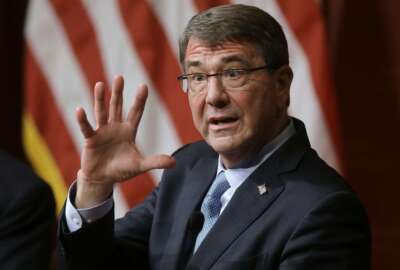
Where diversity initiatives are still falling short in national security jobs
A new report from the Center for a New American Security finds females make up an increasing percentage of the national security workforce, but less so in...
When it comes to eliminating barriers to women serving in national security positions within the U.S. government, there’s plenty of data to show progress. Women now make up 45 percent of the general schedule workforce, compared to 33 percent only 20 years ago. Female admission rates to military service academies and national security-focused graduate studies programs are at all-time highs.
But as a new report from the Center for a New American Security points out, those gains haven’t necessarily translated to proportional increases in women serving at the top of the national security food chain, either because women leave the government workforce at much higher rates than men, or because they’re not promoted at the same rates. As of 2014, only 37.8 percent of GS-14 and GS-15 slots were occupied by women, and females made up 34 percent of the Senior Executive Service.
“And the political appointees are where we see the largest disparity between female representation and male representation,” Katherine Kidder, one of the study’s co-authors, said in an interview for Federal News Radio’s On DoD. “I think in some ways, this demonstrates there are a couple different skillsets at play: rising through the SES ranks is based a lot more on competency than political connections, and this may be demonstrative of an institutional bias in the political positions that doesn’t say anything about their qualifications for those roles.”
The report also points to some unexplained differences between males and females when it comes to the government’s entry points for national security jobs. Although female graduation rates from military academies have been growing, that’s not been true for some of the government’s key programs that recruit people directly from college. The percentage of women hired through the Pathways programs declined between 2010 and 2014 even amid numerous governmentwide initiatives meant to increase diversity within the federal workforce.
One such initiative has been the Defense Department’s Force of the Future, which, in part, sought to increase retention among female service members with more generous maternity leave policies, career “intermissions,” greater permeability between the active and reserve components and other programs intended to make military careers more flexible. But since DoD has relatively little control over governmentwide civil service policies, few comparable changes were enacted for the civilian workforce.
“It raises questions as to why the rest of government is not trying to move in that direction,” Kidder said. “It could have a lot of implications for the civil-military relationship. As individuals are coming up through the pipeline on the civilian side, it would be good to invest in the way we build their career paths that are parallel to the way we’re trying to invest on the military side.”
Latest Defense News
As part of such an investment, the report recommends that much more attention be paid to mentorship within the civilian side of the national security community — and not necessarily in a way that automatically pairs female employees with more senior women.
“Both anecdotally and through our research, we found this idea that mentorship for women is gendered, and there are two issues there,” said Amy Schafer, a CNAS research associate and another of the report’s coauthors. “Sometimes the best person in your specialty is not going to be a woman, and then you lose out on a lot of technical expertise just for the sake of having a female mentor. The second problem is we still don’t have a lot of female mentors to go around, particularly as you go higher and higher. So creating a conversation in this space to have people mentored by the best possible person — whether they’re male or female — is really critical.”
The authors also suggest it’s time to stop thinking about personnel policy changes that improve work-life balance as primarily benefits to women. Indeed, a third of all SES employees who decided to leave government in 2015 cited high job stress as a “great” or “very great” influence on their decision to move to the private sector or retire.
Kidder said even within the military, the message behind the Force of the Future initiative “fell flat” with many of the Pentagon’s senior uniformed leaders because DoD didn’t adequately convey the value of having a diverse workforce and how it related to national security.
“Those leaders had to ask the question, ‘Is this part of some kind of social movement, or is this for military effectiveness?’ But we can make the case that we have a range of threats the United States is facing — whether it’s Iran or North Korea or countering violent extremism — and we really do need to have the top talent competing to sit in positions where they’re actually making the decisions,” she said. “The question now, at least with the budget President Trump has put forward, is how we expand military end strength well. This is an inflection point where we can think through a new strategy of including women in order to make more effective combat teams.”
Copyright © 2024 Federal News Network. All rights reserved. This website is not intended for users located within the European Economic Area.
Jared Serbu is deputy editor of Federal News Network and reports on the Defense Department’s contracting, legislative, workforce and IT issues.
Follow @jserbuWFED





